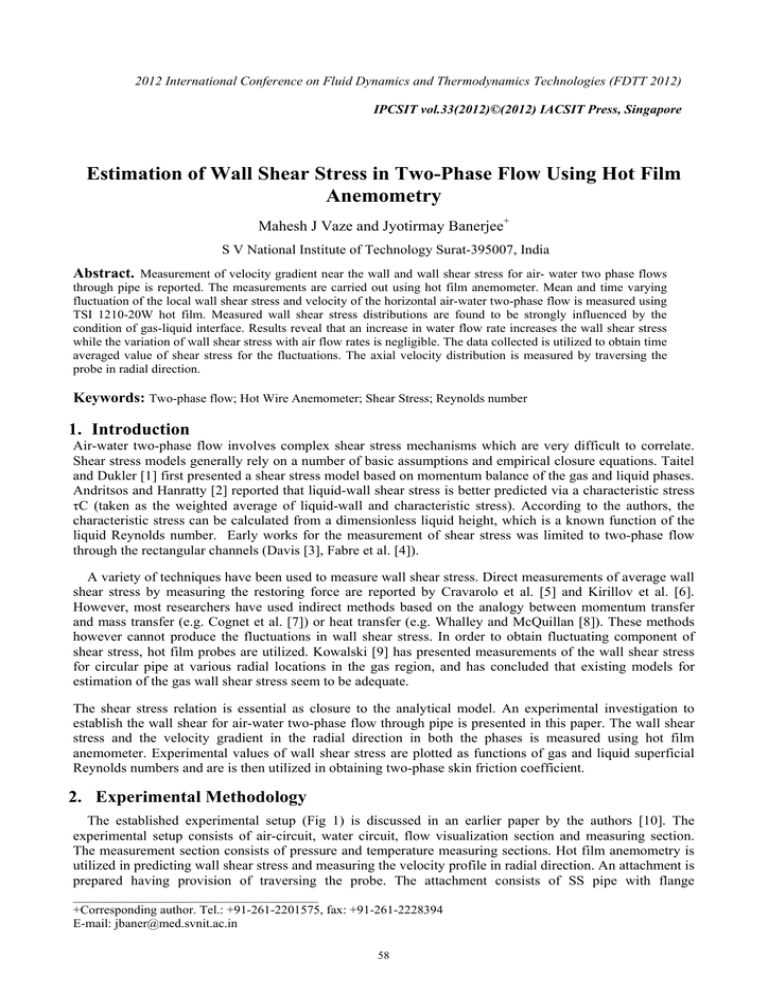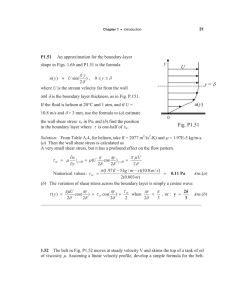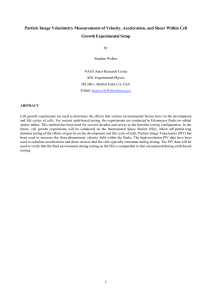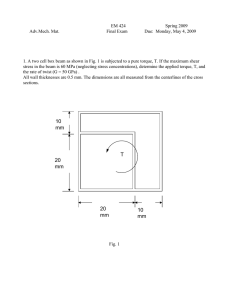Estimation of Wall Shear Stress in Two-Phase Flow Using Hot... Anemometry Mahesh J Vaze and Jyotirmay Banerjee
advertisement

2012 International Conference on Fluid Dynamics and Thermodynamics Technologies (FDTT 2012) IPCSIT vol.33(2012)©(2012) IACSIT Press, Singapore Estimation of Wall Shear Stress in Two-Phase Flow Using Hot Film Anemometry Mahesh J Vaze and Jyotirmay Banerjee+ S V National Institute of Technology Surat-395007, India Abstract. Measurement of velocity gradient near the wall and wall shear stress for air- water two phase flows through pipe is reported. The measurements are carried out using hot film anemometer. Mean and time varying fluctuation of the local wall shear stress and velocity of the horizontal air-water two-phase flow is measured using TSI 1210-20W hot film. Measured wall shear stress distributions are found to be strongly influenced by the condition of gas-liquid interface. Results reveal that an increase in water flow rate increases the wall shear stress while the variation of wall shear stress with air flow rates is negligible. The data collected is utilized to obtain time averaged value of shear stress for the fluctuations. The axial velocity distribution is measured by traversing the probe in radial direction. Keywords: Two-phase flow; Hot Wire Anemometer; Shear Stress; Reynolds number 1. Introduction Air-water two-phase flow involves complex shear stress mechanisms which are very difficult to correlate. Shear stress models generally rely on a number of basic assumptions and empirical closure equations. Taitel and Dukler [1] first presented a shear stress model based on momentum balance of the gas and liquid phases. Andritsos and Hanratty [2] reported that liquid-wall shear stress is better predicted via a characteristic stress τC (taken as the weighted average of liquid-wall and characteristic stress). According to the authors, the characteristic stress can be calculated from a dimensionless liquid height, which is a known function of the liquid Reynolds number. Early works for the measurement of shear stress was limited to two-phase flow through the rectangular channels (Davis [3], Fabre et al. [4]). A variety of techniques have been used to measure wall shear stress. Direct measurements of average wall shear stress by measuring the restoring force are reported by Cravarolo et al. [5] and Kirillov et al. [6]. However, most researchers have used indirect methods based on the analogy between momentum transfer and mass transfer (e.g. Cognet et al. [7]) or heat transfer (e.g. Whalley and McQuillan [8]). These methods however cannot produce the fluctuations in wall shear stress. In order to obtain fluctuating component of shear stress, hot film probes are utilized. Kowalski [9] has presented measurements of the wall shear stress for circular pipe at various radial locations in the gas region, and has concluded that existing models for estimation of the gas wall shear stress seem to be adequate. The shear stress relation is essential as closure to the analytical model. An experimental investigation to establish the wall shear for air-water two-phase flow through pipe is presented in this paper. The wall shear stress and the velocity gradient in the radial direction in both the phases is measured using hot film anemometer. Experimental values of wall shear stress are plotted as functions of gas and liquid superficial Reynolds numbers and are is then utilized in obtaining two-phase skin friction coefficient. 2. Experimental Methodology The established experimental setup (Fig 1) is discussed in an earlier paper by the authors [10]. The experimental setup consists of air-circuit, water circuit, flow visualization section and measuring section. The measurement section consists of pressure and temperature measuring sections. Hot film anemometry is utilized in predicting wall shear stress and measuring the velocity profile in radial direction. An attachment is prepared having provision of traversing the probe. The attachment consists of SS pipe with flange ______________________________________ +Corresponding author. Tel.: +91-261-2201575, fax: +91-261-2228394 E-mail: jbaner@med.svnit.ac.in 58 connections at both the ends. Two micrometers are provided, one on the upper side and other on lower side of the pipe through which probe passes. In addition there are glass windows on front and back side (Fig. 1). The Hot film anemometer used here is a Constant Temperature Anemometer (CTA) which works on the principle of fluid convection. Probe voltage is measured by CTA IFA300 manufactured by TSI. 1. 2. 3. 4. 5. 6. Storage Tank Centrifugal Pump By-pass line Ball valve Gate valve Rotameter (water) 7. Screw compressor 8. Pressure regulator 9. Orificemeter/Rotameter (air) 10. Mixing/Calming zone 11. Visualization zone 12. Heat transfer section 13. Pressure measurement section 14. Hot film attachment 15. Air vent duct 16 and 17. Return line 1 and 2 18. Line to the storage tank P1, P2 Pressure transmitters Fig. 1 Schematic of experimental setup along with Hot Film Probe 3. Calibration The calibration program has three steps: (1) Inserting probe data, (2) Generation of auto calibration table and (3) Condition set up. The first step involves specification of probe data related to probe type, cable resistance, operating resistance, wire film, offset and gain. This is followed by the generation of an auto calibration table by selecting the minimum and maximum velocity and number of points. The values of velocity and corresponding value of dP in mm Hg is presented in the auto calibration table. The value of dP is inserted and bridge voltage E is acquired. Calibration curve obtained by this procedure is as shown in Fig 2. Curve fitting is done using polynomial of second order for velocity as shown in figure. Calibration for shear stress measurement is carried out by allowing single-phase (either water or air) in to the test section. Mass flow rate corresponds to the value of shear stress is fixed by controlling the ball valve. Similar to the velocity calibration, the corresponding mass flow rate is calculated and fixed by controlling the ball valve. The probe is maintained at constant temperature by a standard hot-film anemometry circuit. A laminar thermal boundary layer grows on the probe in the direction of flow and the instantaneous average heat transfer coefficient for the probe is proportional to the heat flux which is in turn proportional to the square of the voltage drop, E. In an ideal developing laminar boundary layer, the heat transfer coefficient is proportional to τ1/n. Shear stress calibration curve obtained for the air and water medium is shown in Fig 2 along with the curve fitted equations. In two-phase flow there is a wall liquid film which is sufficient for the wall shear stress probe operation. Therefore, as shown by Martin [12] and Whalley and McQuillan [8], the probe operation in single-phase and in two-phase flows is essentially the same. The instantaneous wall shear stress is determined from the instantaneous bridge output. Mean values of the shear stress can then be obtained by Meanτ w = 1 N ∑τ w,i N i =1 In order to eliminate uncertainty resulting from the hot film sensor drift, the consistency of single-phase flow anemometer output is frequently checked with the calibration data. 59 (b) (a) For air medium: E2 = 0.580069 + 0.50496ττ0.50 Foor water mediuum: 0.1 E2=12.698+0.386τ = τ1/n (c) τ1/n (dd) Fig. 2: Calibration curve c for veloocity measurem ment in (a) waater medium (b) ( air medium m and shear strress measuurement in (c) air medium (d) ( water mediium 4 Veloccity Measu 4. urement The micrometer m faacilitates thee measuremennt of radial locations l of the probe. M Measurementts are carriedd out at numbber of radial locations l forr different vaalues of superrficial liquidd and gas Reyynolds numb ber (ReSL andd ReSG). Variaation of axiaal velocity prrofile shown here is limitted to stratified and annular type of fllow. Fig. 3(aa) represents thhe velocity profile p for strratified flow w at constant ReSL of 705 and two ReSSG of 831 and d 1635. Thiss plot is show wn here to reppresent the effect e of variiation of ReSG y distributionn keeping ReeSL constant.. S on velocity Fig. 3(a) deepicts pronouunced effect of ReSG on velocity v distribution in thhe gas phasee. Velocity profile p in gass phase is sym mmetric withh a maximum m which shiffts towards up pper wall suurface with inncrease in gaas superficiall Reynolds number. n Thiss increases thhe normal coomponent off the stress. Due to this waves are generated g onn gas-liquid interface. i Thhese waves go g on increaasing with th he ReSG. Thee liquid phaase axial velo ocity profilee shows negliigible influennce due to inncreasing ReeSG for the raange of Reynnolds numbeers considereed here. Fig.. 3(b) represeents the veloocity profile for annularr flow at ReSL = 7659 and a ReSG = 228294 and 33952. 3 Clearr distinction between b the annulus of liiquid and gass core is obseerved. 60 ReSL = 705 25 ReSL = 7659 255 ReSG = 831 ReSG = 33952 ReSG = 28294 200 Radial Distance (mm) Radial Distance (mm) ReSG = 1635 20 15 10 5 0 155 100 5 0.2 0.4 0.6 0.8 1.0 0 1.2 2 V Velocity (m/s) 4 6 8 10 12 14 16 Velocity (m/s) (a) (b) Fig 3: Axial velocity profi file along radiaal direction fo or (a) Stratifiedd flow (b) Annnular flow 5. Prediiction of Shear S Strress (a) (b) Fig. 4: Variationn of liquid-w wall shear streess with (a) Re R SG and (b) ReSL For inteermittent typpe of flow patterns, it is very difficu ult to predictt which phase come in contact c withh inner surfacce of the pipe. Hence, invvestigation here h is restriccted to stratiified, wavy aand annular type t of flow w regime onlyy. Range off ReSG and Re R SL consideered here aree 801-11858 and 822-50080, respectiively. Fig. 4 represents thhe variation of liquid-waall shear stresss as function n of ReSG and ReSL. Careeful observation of figuree reveals thatt there is an increase in mean m value of liquid-waall shear streess with the iincrease ReSG s S as well as ReSL. It is also a observeed that the vaariation of gas–wall g sheear stress (τwG ) is not sig gnificant as compared c to o w liquid wall shear stress (τwL) as is depicted d in Fig. F 4(a). Moreover therre is negligibble effect of variation off liquid superrficial Reynoolds numberss on variationn of gas walll shear stresss (τwG). Samee is clearly viisible in Fig.. 4(b). Mean wall w shear strresses obtainned experimeentally are pllotted against two-phase friction facto or fTP in Fig.. 5. The curvve fitting of the experim mental date reesults in the following expression e foor the two-ph hase frictionn factor fTP: fTP = 0.046 Re −m0.2 R num mber = ρmνmdd/μm ; ρm is th he mixture where, fTP is two-phasee friction facttor; Rem is• thhe mixture Reynolds density = (11-α)ρL + α ρG; sity = (1-α)μ μL + α μG, vm is the mixturre velocity = vSL + vSG G μm is the miixture viscos and α is the volume fracction = vSG/ vSL + vSG. 61 τw, Pa 1.2 2 1 0.8 8 0.6 6 ReSL = 2406 ReSL = 1970 0.4 4 ReSL = 1163 ReSG = 801 1.4 4 ReSG = 1576 1.6 6 ReSL = 8222 ReSL = 1163 ReSL =15338 ReSL = 19970 ReSL = 24406 ReSG = 2326 1.8 8 ReSG = 3052 ReSG = 11858 Re = 10083 ReSGSG= 9101 8050 ReReSG == 7497 ReSGSG = 6925 Re = 6333 = 5720 ReSGSG ReSG = 5087 ReSG = 4431 ReSG = 3753 2 ReSL = 5080 0.2 2 ReSL = 3434 ReSL =1538 ReSL = 8222 0 0.0045 0 0.005 0.00555 0.006 0.0065 0 0.0007 0.00755 0.008 f = 0.046 Re R m-0.2 Fig 5: Variaation of meann τw with f fo or different Re R SG and ReSLL τw =3.098 τw =1.276 10000 P 8000 Re SL SBA τw =7.913 A 6000 S 4000 SW WA τw =1.574 2000 W St 0 10000 20000 Re SG 30000 τw = 0.156 F 6: Time vaariation of sheear stress signaal Fig s stress on o the wall iss captured foor different combinations c s Time histtory of tempporal fluctuattions of the shear of gas and liquid l superfficial Reynollds numbers. These are illlustrated in Figure 6. Reepresentativee shear stresss signals are shown in thhe figure. Thhese represennt the overalll behavior of o wall shearr stress in th hat particularr flow regimee. For the sttratified flow w regime fluuctuations in n shear stress are absentt. These flucctuations aree clearly obseerved in otheer type of flow regime. Pulsations at a regular intterval are obbserved in waavy, annularr and plug floow patterns, while slug flow f exhibitss chaotic natu ure of irreguular pulsationn. Mean sheaar wall stresss obtained froom these fluuctuations depicts that annnular flow has h higher drrag compared to slug flo ow. It is alsoo observed thhat the peak value of sheear stress puulsation in sllug flow reggime is higheer compared d to the peakk values in annnular regim me, although the mean vaalue of shearr stress in annnular flow iis large com mpared to thee mean valuee of shear strress in slug or o any otherr type of flow w patterns foor the considdered range of Reynoldss numbers. 62 6. Closure Hot film anemometry is utilized to measure wall shear stress and axial velocity at discreet radial distances. Axial velocity distribution for the considered Reynolds numbers shows symmetric variation in gas phase. Maxima of gas phase axial velocity shifts toward the upper surface with the increase in gas superficial Reynolds number. This causes the formation of small waves on the gas-liquid surface. Transient fluctuations of wall shear stress observed for various flow patterns represent the behavior of different flow regime. Significant enhancement in mean liquid wall shear stress compared to gas wall shear stress is observed for stratified and wavy flow regime with the increase in gas and liquid superficial Reynolds number. This is due to the viscosity difference between the fluids. These time averaged wall shear stress of stratified, slug and wavy flow (limited Reynolds numbers) are utilized in obtain the variation of wall shear stress with two-phase friction factor for different gas and liquid superficial Reynolds numbers. For the annular flow, wall shear stress variations follow a linear behavior with gas superficial Reynolds number and a non-linear pattern with liquid superficial Reynolds number. 7. References [1] Y Taitel, and A. E Dukler, A model for predicting flow regime transitions in horizontal and near horizontal gas flow. AIChE J. 1976, 22: 47-55. [2] N Andritsos, and T. J., Hanratty. Influence of interfacial waves in stratified gas-liquid flows. AIChE J.1987, 33: 444-454. [3] E.J.Davis. Interfacial shear measurement for two-phase gas-liquid flow by means of Preston tubes. Ind. Eng. Chem. Fundam.1969, 8:153-159. [4] J. Fabre, L. Masbernat, and C.Suzanne. Stratified flow Part I: local structure, Multiphase Science and Technology. 1987, 3: 285-301. [5] L. Cravarolo, A.Giorgini, A. Hassid and E.Pedrocchi. A device for the measurement of shear stress on the wall of a conduit-its application in the mean density determination in two-phase flow shear stress data in two-phase adiabatic vertical flow. CISE (Milan). 1964, R-82. [6] P. L.Kirillov, I. P.Smogalev, M. Y Suvorov, R. V.Shumsky and Y.Stern. Investigation of steam-water flow characteristics at high pressures. Proc. 6th Int. Heat Transfer Conf., Toronto. 1978, pp. 315-320. [7] G.Cognet, M. Leboucrm and M.Souhar. Wall shear stress measurements by electrochemical probe for gas-liquid two-phase flow in vertical duct, AIChE J. 1984, 30:338-341. [8] P. B. Whalley and K. W.McQuillan. The development and use of a directional wall shear stress probe. 2nd Int. Conf. on Multiphase Flow London, 1985, Paper G2. [9] J. E.Kowalski. Wall and interfacial shear stress in stratified flow in a horizontal pipe, AIChE J. 1987, 33: 274. [10] M J Vaze, and J Banerjee, Experimental visualization of two-phase flow patterns and transition from stratified to slug flow. Proceedings of the Institution of Mechanical Engineers, Part C, Journal of Mechanical Engineering Science. 2011, 225: 382-389. [11] C J. Martin. The non-intrusive measurement of wall shear stress and velocity profiles in vertical annular two phase flow. In: Proc. new experimental techniques in heat transfer. ASME. 1984, pp. 47-54. 63






